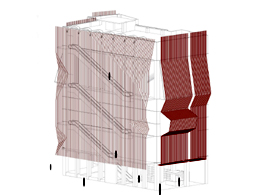STUDENTS PROJECTS
PROJECTS2012
Student: Vlassi Georgia
Supervising prof.: Apostolos Kalfopoulos
Aristotle University of Thessaloniki dept. of Architecture
Presentation date: July 2012
The way information is produced and spread in our time changes the traditional way it is gathered and categorized as well as its retrieval process.
Faced with a new type of collecting, categorizing and storing digital information, it looks like there is a need to move even further then the hybrid library typology where print documents and digital collections co-exist and try to find a new typology where the library deals solely with digital data.
A lack of previous paradigms in the field, urged this thesis right from the start, to compose an original typology through studying relative existent works, traditional library typologies, logistics and logic diagrams taken from programming.

All the above, as well as basic acceptances concerning the synthesis of the collections and their management, delivered a digital library program surrounded by several other uses that support the communion and promotion of digital knowledge.
This process is analyzed onto two counter-directional courses that compose the main stages after the entry of the data and users, respectively. Their meeting point signifies the interaction between information and users.

To fully describe this informational organization, all the needs in electrical and mechanical installations as well as non-countable qualities are developed into a series of diagrams.

Having described to the fullest the internal functional system of the digital library, there was a need to gain physical substance and therefore a built background to take flesh. A long process of critical sorting of urban voids ended up with the skeleton howl in the crossing of Tsimiski and Katouni streets in the Ladadika district in the city of Thessaloniki.


Intervening in the building skeleton, removing whole or parts of slabs and staircases as well adding new external staircases was necessary to allow public use.

After placing the predefined spaces of the new typology inside the building background, all the internal diagrams had to be reformed according to the spatial limitations. This resulted in places to extend beyond the boundaries of the existing skeleton, creating 'lumps' on the surfaces, self-organizing the geometry of its external appearance. The final result is a synthesis of the internal diagram development and the translation of the non-countable diagrams into handlings of circulation, visual connectivity, assuring or not of accessibility and finally, covering the volume with a metal net, capable of protecting the internal of the building and the users.













